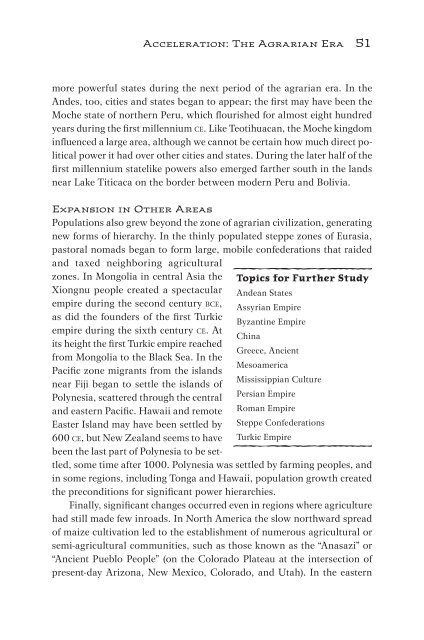This Fleeting World
This Fleeting World
This Fleeting World
Create successful ePaper yourself
Turn your PDF publications into a flip-book with our unique Google optimized e-Paper software.
Acceleration: The Agrarian Era 51<br />
more powerful states during the next period of the agrarian era. In the<br />
Andes, too, cities and states began to appear; the first may have been the<br />
Moche state of northern Peru, which flourished for almost eight hundred<br />
years during the first millennium ce. Like Teotihuacan, the Moche kingdom<br />
influenced a large area, although we cannot be certain how much direct political<br />
power it had over other cities and states. During the later half of the<br />
first millennium statelike powers also emerged farther south in the lands<br />
near Lake Titicaca on the border between modern Peru and Bolivia.<br />
Expansion in Other Areas<br />
Populations also grew beyond the zone of agrarian civilization, generating<br />
new forms of hierarchy. In the thinly populated steppe zones of Eurasia,<br />
pastoral nomads began to form large, mobile confederations that raided<br />
and taxed neighboring agricultural<br />
zones. In Mongolia in central Asia the Topics for Further Study<br />
Xiongnu people created a spectacular Andean States<br />
empire during the second century bce,<br />
Assyrian Empire<br />
as did the founders of the first Turkic<br />
Byzantine Empire<br />
empire during the sixth century ce. At<br />
China<br />
its height the first Turkic empire reached<br />
Greece, Ancient<br />
from Mongolia to the Black Sea. In the<br />
Mesoamerica<br />
Pacific zone migrants from the islands<br />
Mississippian Culture<br />
near Fiji began to settle the islands of<br />
Polynesia, scattered through the central<br />
Persian Empire<br />
and eastern Pacific. Hawaii and remote Roman Empire<br />
Easter Island may have been settled by Steppe Confederations<br />
600 ce, but New Zealand seems to have Turkic Empire<br />
been the last part of Polynesia to be settled,<br />
some time after 1000. Polynesia was settled by farming peoples, and<br />
in some regions, including Tonga and Hawaii, population growth created<br />
the preconditions for significant power hierarchies.<br />
Finally, significant changes occurred even in regions where agriculture<br />
had still made few inroads. In North America the slow northward spread<br />
of maize cultivation led to the establishment of numerous agricultural or<br />
semi-agricultural communities, such as those known as the “Anasazi” or<br />
“Ancient Pueblo People” (on the Colorado Plateau at the intersection of<br />
present-day Arizona, New Mexico, Colorado, and Utah). In the eastern


